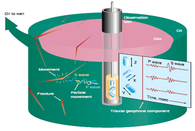Acoustic Wave Emission for Enhanced Oil Recovery
More than 50 % of the original oil in place remains in subsurface reservoir after primary and secondary recovery processes (EOR). Physical and geological factors are behind this low recovery. The main physical reasons are the existence of interfacial tension forces between solids and liquids, and liquid and liquid and the difference between rheological properties of oil and water that results in the entrapment of immobile residual oil saturation in the formation. The main geological factor is the heterogeneity of the reservoir, which leads to a faster sweep of oil from zones with high permeability, leaving behind oil in low permeability zones. Excessive production of water as a result of heterogeneities or fractures often causes channeling of water coning.
There are many factors may prevent the conventional EOR technique from being successful, such as salinity, temperature, type of minerals in the rock such as clay, which has the tendency to adsorb the injected chemicals. Therefore, the application of the conventional EOR methods is not always economical. New methods are required to improve the recovery of existing oil fields and to recover oil found in pores between rock particles. Advanced EOR methods become more important to extract oil from known resources rather than exploration effort to find new oil accumulation. Efforts are made to develop new techniques with lower application risk. One of these alternatives is the application of wave stimulation. This technique is promising as new well stimulation technology to enhance oil recovery and/or to remove formation damage around the wellbore. In the project “WAVE.O.R.” the potential of the sound and ultrasound waves to enhance oil recovery will be investigated as an alternative method to the conventional EOR.
Goals
In this project, a laboratory experiments on core samples will be conducted under reservoir conditions to investigate the applicability of sound waves as an effective method to transport energy through the reservoir with the aim of oil mobilization. In addition, the identification of the main reasons behind the additional recovery will be conducted. The generation of oscillation would be with different form of signals in a frequency range of 0,5 kHz to 50 kHz with a phase and amplitude high-performance magnetostrictive actuator. The results of laboratory investigation will be verified in a field pilot test. For this purpose the newly developed SPWD (Seismic Prediction While Drilling) borehole prototype will be modified based on the laboratory experiments to fulfill the field requirement.



